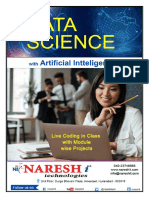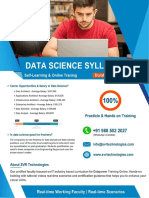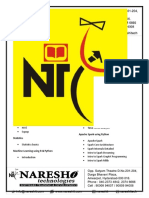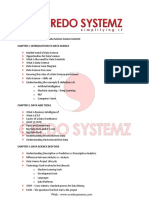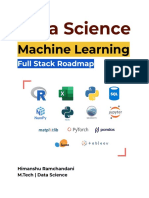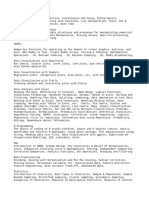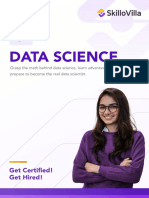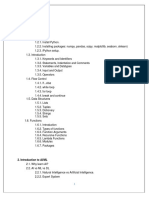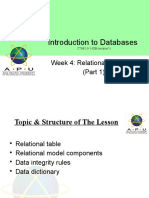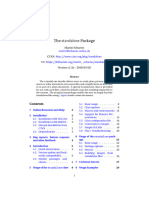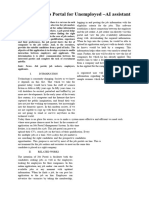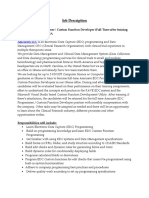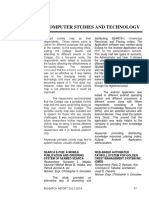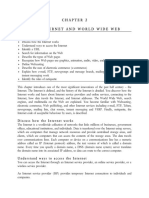EdYoda
Data Scientist Program
Program Curriculum
www.edyoda.com hello@edyoda.com
� Learning outcomes:
• Strong fundamental concepts of Frontend Development
• Strong fundamental concepts of Server-side Development using REST APIs
• Work with database seamlessly
• Create beautiful end to end websites
• Gain Industry standard knowledge
Data Wrangling
1. Black Box Introduction to Machine Learning
• What is not Machine Learning
• What is Machine Learning
• Types of ML - Supervised, Unsupervised
• Supervised - Classification, Regression
• Unsupervised - Clustering, Association
• Machine Learning Pipeline
2. Essential NumPy
• Introduction to NumPy
• Creation
• Access
• Stacking and Splitting
• Methods
• Broadcasting
3. Pandas for Machine Learning
• Introduction to Pandas
• Understanding Series & DataFrames
• Loading CSV,JSON
• Connecting databases
www.edyoda.com hello@edyoda.com
� • Descriptive Statistics
• Accessing subsets of data - Rows, Columns, Filters
• Handling Missing Data
• Dropping rows & columns
• Handling Duplicates
• Function Application - map, apply, groupby, rolling, str
• Merge, Join & Concatenate
• Stacking, Unstacking & Melting
• Pivot-tables
• Normalizing JSON
• Application - EDA on Employee data, sales data
4. Understanding Visualization:
• Introduction to matplotlib & seaborn
• Basic Plotting
• Title, Labels, Legends, Grid, colormap, xticks, yticks
• Color, linewidth
• Sub Plotting
• Scatter plot
• Histogram
• Bar Graphs
• Plotting distributions
• Plotting 3D data
• Fundamentals of Tableau
Fundamental Maths for Data Scientist
1. Essential Maths & Statistics
• Essential Linear Algebra
• Matrix Operations
• Understanding distributions
• Probability Concepts
www.edyoda.com hello@edyoda.com
� • Calculus
• Understanding distributions
• Mean, Median, Mode, Quantile
• Other statistics Concepts
• Sampling Techniques
Machine Learning
1. Linear Models for Classification & Regression
• Simple Linear Regression using Ordinary Least Squares
• Gradient Descent Algorithm
• Regularized Regression Methods - Ridge, Lasso, Elastic Net
• Logistic Regression for Classification
• OnLine Learning Methods - Stochastic Gradient Descent & Passive Aggressive
• Robust Regression - Dealing with outliers & Model errors
• Polynomial Regression
• Bias-Variance Tradeoff
• Application - House Price, Cancer Prediction, Insurance Prediction
2. Preprocessing for Machine Learning
• Introduction to Preprocessing
• StandardScaler
• MinMaxScaler
• RobustScaler
• Normalization
• Binarization
• Encoding Categorical (Ordinal & Nominal) Features
• Imputation
• Polynomial Features
• Custom Transformer
• Text Processing
• CountVectorizer
www.edyoda.com hello@edyoda.com
� • TfIdf
• HashingVectorizer
• Image using skimage
3. Decision Trees
• Introduction to Decision Trees
• The Decision Tree Algorithms
• Decision Tree for Classification
• Decision Tree for Regression
• Advantages & Limitations of Decision Trees
• Application - Cloth Prediction
4. Naive Bayes
• Introduction Bayes' Theorem
• Naive Bayes Classifier
• Gaussian Naive Bayes
• Multinomial Naive Bayes
• Bernoulli’s Naive Bayes
• Naive Bayes for out-of-core
• Application - Text Classification, Sentiment Analysis and Spam & Non-spam
classification
5. Composite Estimators using Pipelines & FeatureUnions
• Introduction to Composite Estimators
• Pipelines
• Transformed Target Regressor
• FeatureUnions
• ColumnTransformer
• GridSearch on pipeline
• Application - Author classification
www.edyoda.com hello@edyoda.com
�6. Model Selection & Evaluation
• Cross Validation
• Hyperparameter Tuning
• Model Evaluation
• Model Persistence
• Validation Curves
• Learning Curves
7. Feature Selection & Dimensionality Reduction
• Introduction to Feature Selection
• Variance Threshold
• Chi-squared stats
• ANOVA using f_classif
• Univariate Linear Regression Tests using f_regression
• F-score vs Mutual Information
• Mutual Information for discrete value
• Mutual Information for continues value
• SelectKBest
• SelectPercentile
• SelectFromModel
• Recursive Feature Elimination
• PCA
• SVD
• Application - Credit Risk Prediction
8. Nearest Neighbors
• Fundamentals of Nearest Neighbor Algorithm
• Unsupervised Nearest Neighbors
• Nearest Neighbors for Classification
• Nearest Neighbors for Regression
• Nearest Centroid Classifier
• Application - Nearest neighbour for face inpainting
www.edyoda.com hello@edyoda.com
�9. Clustering Techniques
• Introduction to Unsupervised Learning
• Clustering
• Similarity or Distance Calculation
• Clustering as an Optimization Function
• Types of Clustering Methods
• Partitioning Clustering - KMeans & Meanshift
• Hierarchical Clustering - Agglomerative
• Density Based Clustering - DBSCAN
• Measuring Performance of Clusters
• Comparing all clustering methods
• Application - Grouping similar customers
10. Anomaly Detection
• What are Outliers ?
• Statistical Methods for Univariate Data
• Using Gaussian Mixture Models
• Fitting an elliptic envelope
• Isolation Forest
• Local Outlier Factor
• Using clustering method like DBSCAN
• Application - Anomaly detection for credit risk prediction
11. Support Vector Machines
• Introduction to Support Vector Machines
• Maximal Margin Classifier
• Soft Margin Classifier
• SVM Algorithm for Classification
• SVM for Regression
• Hyper-parameters in SVM
• Application - Face recognition and breast cancer classification
www.edyoda.com hello@edyoda.com
�12. Dealing with Imbalanced Classes
• What are imbalanced classes & their impact?
• OverSampling
• UnderSampling
• Connecting Sampler to pipelines
• Making classification algorithm aware of Imbalance
• Anomaly Detection
• Application - Fraud detection
13. Ensemble Methods
• Introduction to Ensemble Methods
• RandomForest
• AdaBoost
• Gradient Boosting Tree
• VotingClassifier
• XGBoost
• Application - Malicious data detection
14. Recommendation Engine
• Understanding distance vector calculation - cosine, euclidean, manhattan
• Types of Recommendation Engines
• Recommendation based on similarity
• Application - Grouping videos based on description, user rating prediction
15. Time Series Modeling
• Simple Average & Moving Average
• Single Exponential Smoothing
• Holt’s linear trend method
• Holt’s winter seasonal method
• ARIMA
16. Packaging & Deployment
• Creating Python Package
www.edyoda.com hello@edyoda.com
� • Deploy trained model behind REST interface
• Deploy model behind API call
• Deploy on AWS cloud (optional)
Big Data Ecosystem
1. Introduction to Big Data
• Big Data
• Understanding distributed computing
• Introduction to Hadoop
• HDFS, YARN, MapReduce
• Limitations of Hadoop
• Introduction to Spark
• Introduction to Kafka
• Hive
• Cassandra
2. Internal Details of Spark
• Driver
• Executors
• Partitions
• Jobs
• Stages
• Tasks
• Resilient Distributed Datastructure
• DataFrames as a High Level Datastructure
3. Foundations of Spark using RDD
• Basics of Distributed Computing
• Resilient Distributed Dataset
• Simple Transformers - map,filter,groupby
www.edyoda.com hello@edyoda.com
� • Actions - Collect, count, foreach
• Complex api - combinebykey
• Caching, Debugging
• Important Configuration
4. Data Wrangling using DataFrames
• Creating DataFrames from collections
• Creating a DataFrame from csv,json etc.
• DataFrame Row
• DataFrame Column
• Creating tables from dataframe
• SQL query
• DataFrame Grouping
• DataFrame Functions
• User Defined Functions (UDF)
5. Packaging & Deployment of Spark Applications
• The spark-submit command
• Command line parameters
• Deploying the app programmatically
• Configuring your SparkSession
• Modularizing code
• Structure of the module
• Building an egg
• User defined functions in Spark
• Submitting a job
• Monitoring execution
www.edyoda.com hello@edyoda.com
� Mindset for Problem Solving
1. Mathematical Aptitude
• Percentages
• Profit and Loss
• Simple Interest and Compound Interest
• Work And Time
• Probability
• Permutation and Combination
• Profit and Loss
• Time & Speed
• Ratios and Proportions
• Data Interpretation
2. Art of Learning Anything
• What is Intelligence
• Relation of success with intelligence
• Illusion of Learning
• Focussed Mode vs Diffused Mode
• Procrastination
• Improving Recall
• Creating Brain Links
• Visual memory & Data Memory
• Slow Thinking
3. Computational Thinking
• Thinking before Doing/Coding
• Problem Identification
• Decomposition
• Pattern Recognition
• Abstraction
• Algorithm Design
• Computational Thinking Use Case 1
www.edyoda.com hello@edyoda.com
� • Computational Thinking Use Case 2
4. Technical Puzzles
• Why are Puzzles part of interviews?
• The Art of solving puzzles
• Approach more important than the solution
• Puzzles for Vertical Thinking
• Puzzles for Horizontal Thinking
Productivity and Decision Making
1. Art of being Super Productive
• Start with Why to make objectives clear
• Thinking Limitless
• The magic of computing returns
• Deciding what to work on
• Time Management Skills
• Measuring what matters
• Choosing wisely habits to inculcate
2. Effective Decision Making
• Why is decision making a key skill?
• Components of Decision Making
• Understanding common biases
• Letting emotions not clutter decision making
• Difference between quick decision making & slow decision making
www.edyoda.com hello@edyoda.com
� Professional Communication
1. Reading comprehension & Short writing
• Building vocabulary
• Extracting insights from the textual information
• Drawing inferences from multiple stories
• Writing you inferences for others to understand
•
2. Book Reading & Writing Reviews
• Reading 10 books during the entire course & writing book reviews
• 2 Biographies
• 2 Fictions
• 6 Non-Fictions
3. Effective Understanding & Articulation
• Watching 20 movies from our suggested list
• Writing 1000 words essay on those movies
• Writing a summary of the movies
4. Group Discussion for decision making
• Understanding why GD is so important in personal & professional life
• The objective of GD - Collectively making the right decision
• 5 GD on various topics
5. Writing Professional chat/E-mail
• Writing as the most common method of professional communication
• Factors to keep in mind before starting to write
• Points to consider while writing
• Activities after writing
• Difference between chat writing & email writing
www.edyoda.com hello@edyoda.com
� 6. Making Impressive Presentation
• Why making a presentation is a professional job
• The objective of the presentation
• Attributes of good presentation
• Why research is key to the presentation
• Making a presentation interactive
• Doing 10 video/live presentation
Computer Fundamentals
1. Operating System Concepts
• Operating System Architecture
• Processes and Process Management
• Threads and Concurrency control
• Scheduling
• Memory Management
• Inter-Process Communication
• Synchronization Constructs
• I/O Management
• Resource Virtualization
• Remote Services
• Distributed Systems
• Introduction to Data Center Technologies
2. Linux Administration
• Introduction to Linux Operating Systems
• Basic Linux Commands
• File Management and Security
www.edyoda.com hello@edyoda.com
� • The directory structure of Unix
• User Management
• Groups
• Shell types and basic commands
• Permissions
• sudo
• Systemd Services Start and Stop
• Resource Mgmt with systemctl
• Process Management (top, ps)
• Package Management(yum, apt, rpm)
• Managing disks (lsblk, df, mount, umount,du)
• File systems
3. Data Structures and Algorithms
• Built-in Data Type
o Integers
o Boolean
o Floating
o Character and Strings
• Derived Data Type
o List
o Array
o Stack
o Queue
• Linked List
o Singly Linked List
o Doubly Linked List
o Circular Linked List
• Array
• Stack
• Queue
• Tree
• Basic Operations
o Traversing
o Searching
o Sorting
o Hashing
www.edyoda.com hello@edyoda.com
� o Insertion
o Deletion
o Merging
• Searching techniques
o Binary search
o Linear search
• Recursion
• Fibonacci series
• Sorting Algorithm
o Bubble sort
o Insertion sort
o Selection sort
o Quick sort
o Merge sort
o Bucket sort
4. Database concepts
• Introduction to Databases
• Entity Relationship Model
• Relational Model
• Relational Algebra
• Normalization
• Transactions and Concurrency Control
• DBMS Architecture 2-level 3-level
• Data Abstraction and Data Independence
• Database Objects
• Entity-Relationship Model
• Generalization
• Specialization
• Aggregation
• Entity Relationship Diagrams
• Keys in Relational Model
• Candidate key,
• Super key
• Primary key
• Alternate key
www.edyoda.com hello@edyoda.com
� • Foreign key
• Strategies for Schema design
• Schema Integration
• Data modelling
• Star Schema in Data Warehouse modelling
• Data Warehouse Modeling
5. Basic SQL - Syntax
• Data Types
• Operators
• Expressions
• Create Database
• Drop Database
• Select Queries
• Create Table
• Drop Table
• Other Table Operations
• Insert Query
• Where Clause
• AND & OR Clauses
• Update operations
• Delete operations
• Order By clause
• Group By Clause
• Sorting operations
• SQL Constraints
• Type of Joins
• Unions Clause
• NULL Values
• Indexing
• Views
6. Software Engineering
www.edyoda.com hello@edyoda.com
� • Software Engineering Overview
• Features of Good Software:
o Operational Features
o Transitional Features
o Maintenance Features
• Software Development:
o Requirement Gathering
o Software Design
o Programming
• Software Design
o Design
o Maintenance
o Programming
• Programming:
o Coding
o Testing
o Integration
• Software Development Life Cycle
o Requirement Gathering
o System Analysis
o Software Design
o Coding
o Testing
o Integration
o Deployment
o Operation and Maintenance
• Types of SDLC
o Waterfall model
o Iterative Model
o Spiral model
o V Model
• Agile Concepts
• DevOps Concepts
• Microservices Architecture
• Features of Microservices Architecture
• Software Requirements
• Software Design Basics
• Analysis & Design Tools
o Data Flow Diagram
www.edyoda.com hello@edyoda.com
� o Flow Chart
• Design Strategies
o Function-Oriented Design
o Object-Oriented Design
• User Interface Design
o Command Line Interface(CLI)
o Graphical User Interface (GUI)
• Design Complexity
• Software Testing Overview
o Manual Vs Automated Testing
o Testing Approaches
o Black-box testing
o White-box testing
o Unit Testing
o Integration Testing
o Functionality testing
o Acceptance Testing
o Regression Testing
• Quality Control
• Deployment Methods
o Blue-Green Deployment
o Rolling Deployment
• Software Monitoring
• Software Maintenance
7. Tools
• Git
o What is Git?
o Installing Git
o First-Time Git Setup
o Git Basics
o Getting a Git Repository
o Recording Changes to the Repository
o Viewing the Commit History
o Undoing Things
o Working with Remotes
o Tagging
o Git Branching
o Basic Branching and Merging
o Branch Management
www.edyoda.com hello@edyoda.com
� o Branching Workflows
o Remote Branches
o Rebasing
• Putty
o Installation
o Types of connections
o Connecting to a remote server
o Using Auth keys
o Customizing putty
• Vim
o Vim Basics
o Insert Mode
o Visual Mode
o Command Mode
o Create and Edit a file
o Search and replace in Vim
o Vim diff
o Copy operations
o .vimrc file
o Vim Commands
www.edyoda.com hello@edyoda.com



